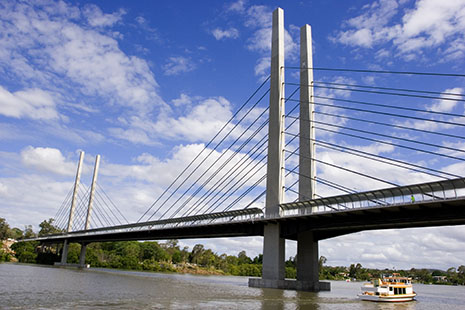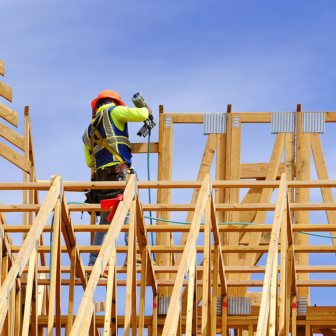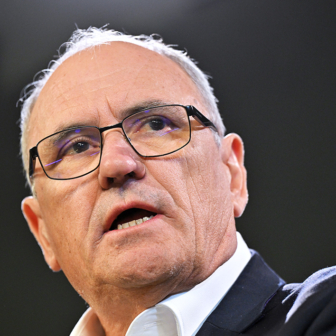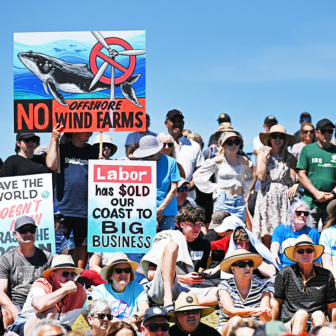AUSTRALIA’s big cities are in trouble. It’s true that they’ve survived the threatened recession courtesy of a vast amount of infrastructure spending, especially on roads, bridges, tunnels and continuing house and apartment construction. Booming real estate markets have hardly eased up, much to the regret of sensible economists. Overseas students still flock to our colleges and universities and help populate the new apartment blocks. The banks still throw money at negatively geared housing investors and can be coerced by first homeowner grants to give low-income earners a once-in-a-lifetime chance of securing a mortgage. And our biggest cities are still growing rapidly. In 2007–08 Melbourne added 74,000 new dwellers, the 200 kilometre city from Noosa to the Tweed 62,500, Sydney 55,000 and Perth 43,400. In percentage terms southeast Queensland is still growing most strongly of all.
Despite, or perhaps because of, all this growth, big-city dwellers are unhappy. Peak-hour traffic gets worse and worse; the cost of water and electricity keeps going up; and local councils provide fewer and fewer services – yet the rates still rise – and have outsourced almost all new building and renovation approvals, so ratepayers have to cough up for those as well. Some state governments seem so incompetent – New South Wales heads the list – that Armageddon appears nigh. The doom-watchers got very excited in 2006 when it looked like Brisbane would run out of drinking water, in 2008 when petrol prices spiked and again this September when Sydney and Brisbane were covered with red dust and they literally ground to a halt. Suddenly climate change came to the front door of every apartment, house, office and school, and there didn’t seem much that our many ministers for climate change – are they for it or against it? – could do.
In the midst of these multiple urban crises state governments continue to churn out regional and city plans to direct growth. In every case these documents have some sound data and some useful mapping of urban phenomena, overlain with softcore urban photography of happy families and happy workers creating instant new communities. All the big issues, from homelessness and the erosion of greenspace to the fate of people who have no access to public transport, are subsumed under headings like “strong communities” and “smart growth.” These documents become more and more fatuous with each “iteration” (the favourite word in an era in which government pronouncements must be tweaked by wordsmiths who will be held accountable if they fall into the mortal error of making a testable promise).
In Perth, responding to the need for longer-term thinking, Richard Weller and a group of fellow architectural researchers have bravely compiled Boom Town 2050: Scenarios for a Rapidly Growing City. This gargantuan volume, 454 pages at $95, will find its way onto the shelves of local architects and graphic designers, but is pitched well beyond what interested citizens are likely to pay. The book is a visual extravaganza, full of tempting possibilities: using hundreds of maps, aerial photographs, tables and scenarios it attempts to convey the possibilities and constraints facing the Perth urban region. Whether your interest is in water, energy, waste, transport, housing or food this book has something for you. As a devotee of narrative non-fiction I find it too discontinuous to add up to a persuasive argument, but Wikipedia editors, architects, town planners, engineers and others who embrace the bititisation of knowledge on the web will no doubt relish the interpretative challenge.
The publication of Weller’s book, and the availability of metropolitan plans for Australia’s four largest urban areas – Sydney, Melbourne, Adelaide and Southeast Queensland – make this a good time to assess where Australian cities are going, and why we might want to change direction.
CENTRAL to the problems faced by Australian cities is transport. In Perth’s case, as Weller points out, fully 20 per cent of the land area of the suburbs is given over to roads. Apart from proposing fewer roads in new developments, he argues that in a car-free suburb all sorts of uses could be made of existing roads, from stormwater filtration to linear public parks. Much of this has already been done reasonably well in Canberra, our most ambitious town-planning experiment, but regrettably the road system there has still been the major driver of the location of new suburbs.
If the media is any guide, Sydney is the prime example of a city in which the road and rail system is in constant crisis. But despite all the criticisms levelled at that city’s public transport, it still carries more people and accounts for a higher proportion of all trips – about 14 per cent – than any other system in Australia. The rail network is extensive and effective, but it is so popular at peak hour that it becomes very congested. But so does rail in London, New York, Tokyo and lots of other big cities. Sydney’s buses cater for the areas unserved by rail, but unlike the retrofitted Brisbane busway system, few of Sydney’s buses have their own right of way. Where they do – as in the bus lanes on the Harbour Bridge – the reduction in travel time is impressive.
When governments look like they are not coping they turn to big spending promises. The NSW Labor government – its fingers burnt by the gross underutilisation of the cross-city tunnel – lurches from one transport promise to another, none of them well thought out. It has all become so embarrassing that Four Corners recently devoted an entire program to the hastily developed plan for a CBD-to-Rozelle “metro.” What a contrast with the carefully designed Bradfield Plan, which gave Sydney its underground railway and the Harbour Bridge. Everyone now rues that the proposed rail line to Manly and Narrabeen wasn’t built at the time.
In Melbourne, the previous state government’s botched privatisation of the rail system has distracted attention from just how extensive the network really is. With a bit more investment it could carry a lot more people. And Melbourne, thankfully, as the only Australian city that didn’t garrotte its tramway system, now revels in the eighth-largest network on the planet. What a civilised way to travel.
Australia’s third-largest city is also preoccupied with the utopian notion of “eliminating gridlock.” Brisbane’s lord mayor, Campbell Newman, is pouring billions of ratepayers’ funds into propping up public–private partnerships to build tunnels, bridges and freeways. Along with the state government, he has also put money into expanding a successful busway system. Understandably, he has little interest in what goes on beyond the council’s borders – and that is where the real trouble starts.
Only 2 per cent of travel on the Gold and Sunshine Coasts is by public transport. There, urban development has been led by a road system that simply cannot cope with the population growth, no matter how much it is augmented. The rail line via Robina has still to reach Coolangatta (the coastal rail line was foolishly closed and the reservation given over to property interests in the early 1960s) and the railway to the Sunshine Coast won’t get there for another fifteen years. Sydney and Perth revel in their surf beaches, relatively well-served by public transport, but in surfless Brisbane you still can’t catch a train to the beach. Instead we have thirty million road pilgrimages per annum as the residents of Brisbane escape to one or other coasts in their 200 kilometre city.
The smaller capital cities have nowhere near the congestion of the big four. In 2007–08 Adelaide grew by 13,000 people, Canberra 4500, Darwin 3300 and Hobart a mere 2000. They all have tolerable public transport systems, though their outer suburbs remain entirely dependent on the private car. The new Adelaide plan, like most other metro plans, advocates “transit oriented developments.” Public servants joke about Canberra’s 20-minute peak hour, but it is disgraceful that its privatised airport, full of offices and seconds shops, is now the most congested place in town. Surely it is the right of all Australian citizens not only to visit their national capital but also to escape it without undue obstruction.
ALL THIS CONGESTION, and the inability to provide public transport efficiently to low-density outer suburbs, have brought repeated calls for greater urban densities. The pros and cons of urban consolidation – in terms of energy use, quality of life, landscape impact and cost of living – have been much debated in recent years. This debate has been sidestepped in the current crop of city plans, because now we have a new, even more slippery term, “compact settlement.” Melbourne and Brisbane have both embraced the concept, aiming for fifteen houses per hectare in new settlements. To put that in perspective, the average Australian housing block has never been “the quarter acre block” of popular mythology – in the experience of people born after 1966 it’s much nearer to a sixth of an acre, or around 600 square metres. To fit fifteen houses into a hectare, you are looking at a maximum block size of 400–500 square metres, leaving land aside for road access.
Or you can go for medium- or high-density housing. Almost all new structures over three storeys now have lifts and air-conditioning throughout, which means they are still highly energy-intensive forms of housing. Architects, despite “green building regulations,” don’t seem to worry much about cross-ventilation any more. The developers never did.
The Victorian government proposes to place the half a million new people it anticipates swelling the metropolitan area in the next thirty years equally between established areas and new growth areas. Most other big-city metro plans have similar aspirations. Developers are encouraged to embrace high-rise in and near the city centres, and in the case of Sydney in the major regional centres as well.
Australia’s large port cities have traditionally been highly centralised, housing government offices, business and transport termini in and near the city core. Sydney has long had Australia’s most effective urban centres, from Chatswood and Parramatta to Hurstville and Blacktown, an achievement celebrated in the title of Sydney’s 2005 metro strategy, City of Cities. All of Sydney’s main centres hang off the rail system, which has even been augmented to service some formerly car-based universities, most notably Macquarie and the University of Western Sydney. And both Sydney and Brisbane have direct rail links to their airports; Melbourne is yet to play catch-up. Like Melbourne, Sydney took hospital decentralisation seriously. Brisbane never has. Over two thirds of all hospital beds in Brisbane are to be found at the three hospitals within five kilometres of the CBD. In the location of state government offices central Brisbane is even more dominant, with government accounting for over one fifth of CBD office lettings, in marked contrast to Sydney and Melbourne, with less than 10 per cent of office space occupied by government.
Office space and the CBD don’t even rate an entry in the sparse index to Weller’s book on Perth. Adelaide, meanwhile, still has plenty of room to grow – and at 1.2 million residents it remains our most civilised large city, with only modest population pressures. But local boosters, as in Canberra and Hobart, would still like to see much stronger population growth.
IN THE FACE of the urban water crisis, most state governments are talking about “waterproofing” their cities. The most popular way to do this is to pour billions of dollars into desalination plants, vastly more energy-intensive than treatment and recycling. Perth has attempted to sidestep the energy problem by using a wind farm to the north of the city, but of course that electricity could equally be used to replace dirtier power used for other purposes. At least Perth has the excuse of being our driest capital. Sydney, Brisbane, the Gold and Sunshine Coasts have much healthier rainfalls. The construction of a desalination plant abutting Coolangatta airport is one of the greatest public policy follies of the new century. There are 100,000 properties on the Gold Coast that could easily have 20,000 litre tanks retrofitted, at half the cost of the desal plant. And that doesn’t take in the cost of pumping the water to Brisbane.
The dominant suburban form of all our capital cities creates a landscape that lends itself to the relatively economical retrofitting of water tanks, which could provide the washing and garden-watering needs of most suburban households, leaving the central water supply for kitchen and bathroom. Regrettably, most state and local governments have abandoned their water tank subsidy, undermining any sense in the electorate that we might take some responsibility for our own survival.
At precisely the time when we should be reducing our dependence on coal-fired power we are embracing desalination, and throwing away the compliance achievement of Brisbane during the drought of 2005–06 when households got their water consumption down to 130 litres per head per day, one of the lowest levels in the developed world.
IN PERTH’s Boomtown 2050 Weller and his colleagues don’t come up with too many solutions but at least they identify the problems and have some suggestions as to possible responses. This is to be applauded: the multiple and often contradictory scenarios outlined in the book will at least get people thinking, in stark contrast to the slippery language that now infects every major government urban-planning document produced in Australia.
Many of the best planning decisions made in Australia’s capital cities can be traced back to the big planning reports produced from the late 1940s to the 1960s, in which coherent arguments were made in continuous prose rather than today’s dot points. If you want to find out what is happening in Australia’s cities today, don’t go to the well-doctored planning glossies. You would be much better advised to attend a major railway station at peak hour, sit in a freeway traffic jam thirty kilometres out of town, bid at a house auction or inspect the abandoned excavation for a failed inner-city office block or apartment tower. Thank goodness the “Rudd Bank” never got up, otherwise we’d have an even greater rash of energy-intensive buildings that require us to burn coal merely to allow their occupants to move from floor to floor. •
Boom Town 2050: Scenarios for a Rapidly Growing City
by Richard Weller
University of WA Press, 2009, $95
South East Queensland Regional Plan 2009–2031
Department of Infrastructure and Planning Brisbane, 2009
Melbourne @ 5 Million: A Planning Update
Department of Planning and Community Development, 2009
City of Cities: A Plan for Sydney’s Future
Department of Planning, 2005




